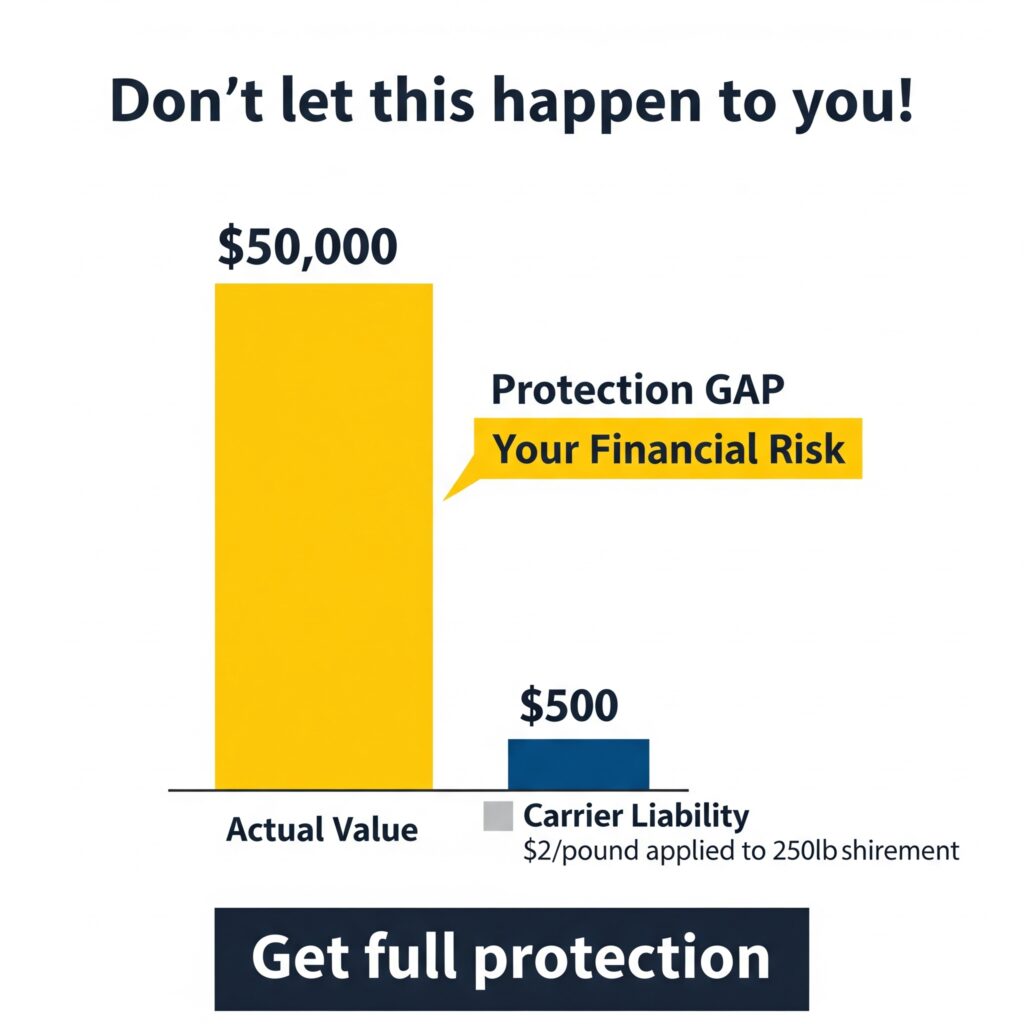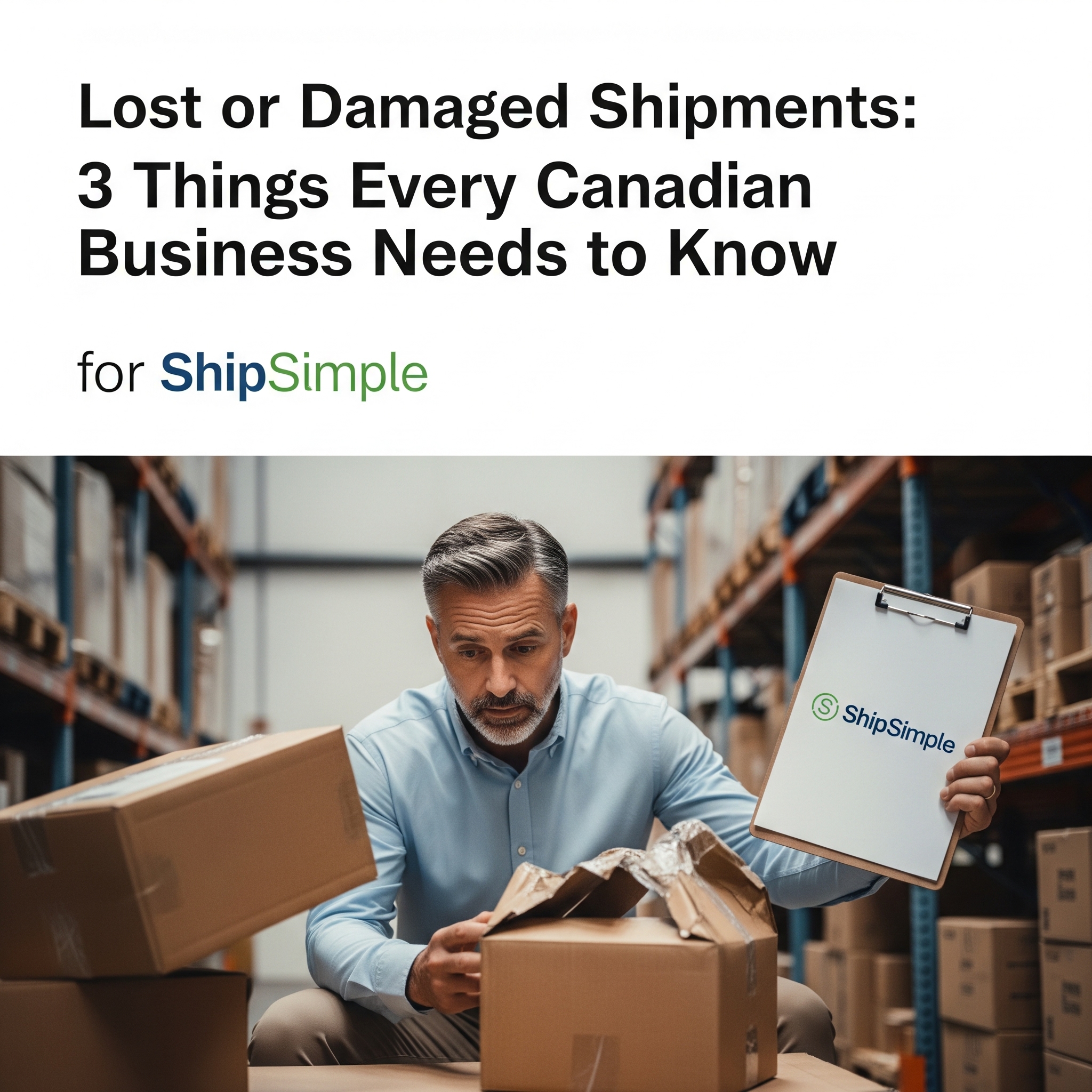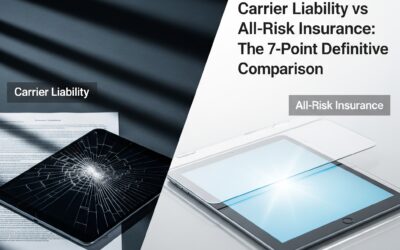Lost or Damaged Shipments: Understanding Your Financial Risk
As a business owner, you know the satisfaction of sending out a valuable order. You’ve carefully packed your product, printed the label, and handed it off to the carrier, trusting it will arrive safely in your customer’s hands.
But then you get the dreaded call or email: “My package never arrived,” or worse, “It arrived, but it’s broken.”
In that moment, a hundred questions flash through your mind. What happens next? How do you replace the order? And the most critical question of all: Who pays for the loss? The answer is far more complex than most people think – and if you don’t know the facts, your business could be facing a catastrophic financial loss.
This guide will reveal the three critical things every Canadian business owner needs to understand about shipment protection and how it can safeguard your business when dealing with lost of damaged shipments. What you learn here will change the way you think about shipping forever.
1. The “Declared Value” Myth: Your Stated Value is NOT Your Insurance Coverage
This is one of the most common and costly misconceptions in shipping. When you create a shipping label, you are often asked to declare the value of the goods inside. Many shippers logically assume that by declaring a value of, for example, $2,000, they are telling the carrier, “This item is worth $2,000, and if you lose it, you owe me $2,000.”
Unfortunately, that’s not how it works.
In most cases, the “declared value” is used by the carrier primarily for record-keeping, customs assessments, and determining their own liability limits. It is not an insurance policy. Stating the value does not automatically mean the carrier will reimburse you for that amount if the shipment is lost or damaged. It simply establishes the carrier’s maximum possible liability, which is subject to their own restrictive terms and conditions.

2. The Shocking Truth About “Carrier Liability”
If declared value isn’t insurance, then what is the carrier actually responsible for? The answer lies in a concept called “carrier liability” or “limitation of liability.” This is not insurance coverage for your benefit; it is a legal limit on the carrier’s financial responsibility, designed to protect them, not you.
The $2/lb Rule
For most carriers in Canada and the US, their standard liability is limited to a maximum of $2 per pound (or $4.41 per kilogram), up to a certain total. This is the industry standard for ground shipments.
Let that sink in. The carrier’s payout is based on the weight of your package, not the actual value of the goods inside.
Let’s Do the Math: Real-World Scenarios
The financial gap this creates can be devastating. Let’s look at a few common examples:
- Scenario A: High-Value Electronics You ship a box of specialized electronics that weighs 10 lbs and has an invoice value of $5,000. The package is lost in transit.
- Carrier’s maximum liability payout: 10 lbs x $2/lb = $20.00
- Your total financial loss: $4,980.00
- Scenario B: Designer Fashion You ship a 20 lb box of boutique dresses to a retailer, valued at $3,000. The box is damaged by water in the carrier’s facility.
- Carrier’s maximum liability payout: 20 lbs x $2/lb = $40.00
- Your total financial loss: $2,960.00
- Scenario C: Automotive Parts You ship a critical automotive component that weighs 150 lbs and is worth $8,000. The part is damaged by a forklift during sorting.
- Carrier’s maximum liability payout: 150 lbs x $2/lb = $300.00
- Your total financial loss: $7,700.00
In every scenario, the business owner is left covering nearly the entire cost of the lost or damaged shipments, wiping out the profit from that sale and many others.
The Burden of Proof
To make matters worse, even getting that minimal $2/lb payout isn’t guaranteed. To process a liability claim, carriers often require the shipper to prove that the loss or damage was a direct result of the carrier’s own negligence. This can involve extensive paperwork, photographs, and a lengthy, frustrating claims process that can take months to resolve, with no guarantee of success.

3. The Solution: Closing the “Protection Gap” with Shipper’s Interest Insurance
After seeing the numbers, the situation can feel bleak. But there is a straightforward and powerful solution designed specifically to close this massive protection gap: Shipper’s Interest Insurance.
What is Shipper’s Interest Insurance?
Shipper’s Interest Insurance is a separate, first-party insurance policy that you, the shipper, purchase specifically to protect your financial interest in the goods you are sending. Think of it not as an add-on to the shipment, but as your own dedicated business insurance policy that covers your products from the moment they leave your hands until they are safely received by your customer. It operates completely independently of the carrier and their restrictive liability limits.
The term “first-party” is critical. It means the policy is between you and your insurance provider (like ShipSimple), not you and the shipping carrier. This completely changes the dynamic of a claim. Instead of navigating a difficult claims process with a carrier who has an inherent conflict of interest, you work directly with a partner whose purpose is to help you. The focus is on verifying the loss and making you financially whole, not on debating whether the carrier was technically at fault.
This independence is what makes Shipper’s Interest Insurance so powerful. It removes the “burden of proof” from your shoulders. The trigger for a claim is no longer proving carrier negligence; it’s simply demonstrating that your shipment was lost or damaged while in transit. This simplifies the process immensely, reducing the required paperwork and cutting down the time it takes to get your money from months to mere days.
Ultimately, its purpose is simple and profound: to cover the full invoice value of your products. If your invoice to the customer was for $2,500, that is the amount you are insured for. This doesn’t just cover the cost of the materials; it protects your cash flow, the time and labor you invested, and the profit margin on the sale. It’s the only way to ensure that a logistics issue out of your control doesn’t erase your hard-earned revenue.
How It Works in the Real World
Let’s revisit our first scenario. You are shipping that $5,000 box of electronics, but this time, you have Shipper’s Interest Insurance. The package is lost.
Instead of fighting with the carrier for a $20 payout, you simply file a claim with your insurance provider (like ShipSimple). Once approved, you are reimbursed for the full $5,000. This allows you to immediately reship the order to your customer or refund them completely without taking a devastating financial hit. You’ve protected your revenue, your cash flow, and your customer relationship.
The Two Magic Words: “All Risk”
Not all insurance is created equal. The best and most comprehensive type of Shipper’s Interest coverage is known as “All Risk” insurance. While basic policies might only cover a few specific “named perils” (like fire or flood), an All Risk policy is designed to cover any and all potential causes of loss or damage, unless a peril is specifically excluded in the policy document. This provides the broadest and most secure form of protection available.
You Have Options: Don’t Leave Your Business Exposed
Relying on the free, included “protection” from a carrier is one of the biggest financial risks a modern business can take. A single lost or damaged high-value shipment can wipe out a week’s or even a month’s worth of profit.
Viewing proper shipping insurance not as a “cost,” but as a vital business tool is a critical shift in mindset. It’s a tool that protects your cash flow, safeguards your hard-earned customer relationships, and provides invaluable peace of mind. With the right protection, you can ship your products with confidence, knowing that you are covered no matter what happens on the journey.

Conclusion: Stop Taking Unnecessary Risk
The reality of logistics is that lost or damaged shipments are an unavoidable part of doing business. The critical difference between a thriving company and one that struggles lies in how they prepare for that reality. Relying on basic carrier liability is not a strategy; it’s a gamble where you accept nearly all the financial risk for any incidents that occur. As we’ve shown, the minimal payout based on weight, not value, leaves your business dangerously exposed.
Now you know the three critical truths of shipping protection:
- Declared Value is not an insurance policy.
- Carrier Liability is minimal and designed to protect the carrier, not your bottom line.
- Shipper’s Interest Insurance is the only way to cover the full value of your goods and close the massive protection gap.
A proactive plan for lost or damaged shipments transforms a potential financial crisis into a simple, manageable operational issue. Instead of absorbing a huge loss, you can confidently reship an order, knowing your revenue is protected. Don’t let the threat of lost or damaged shipments undermine your profitability and the trust you’ve built with your customers. It’s time to evaluate your shipping process and implement a solution that ensures your business is truly protected.
Curious to see how easy it is to protect your shipments?
–> Explore the ShipSimple Platform and Sign Up for Free Today
Ready to see how affordable real coverage can be for your products?
–> Get an Instant Insurance Quote for Your Next Shipment
Additional Resources
- Canadian Transportation Agency – A Guide to Contracts and Liability Rules
https://otc-cta.gc.ca/eng/publication/a-guide-to-contracts-and-liability-rules- This official guide from the Canadian Transportation Agency explains the legal framework governing liability for lost or damaged goods, providing an authoritative, non-commercial source for the concepts discussed in our article.
- Entrepreneur Magazine – A Small Business Guide to Shipping and Fulfillment
https://www.entrepreneur.com/growing-a-business/a-small-business-guide-to-shipping-and-fulfillment/434033- This article provides a broad overview of shipping for small businesses, highlighting the importance of considering factors like insurance and risk management.
- The Balance – What Is Cargo Insurance and What Does It Cover?
https://www.thebalancemoney.com/what-is-cargo-insurance-and-what-does-it-cover-4588075- An informational article from a financial publication that defines cargo and shipping insurance, reinforcing the concepts discussed in this guide.





